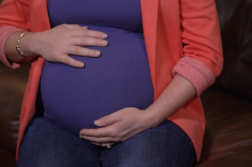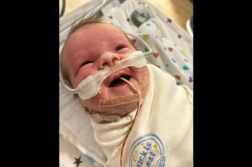DALLAS, Texas (Ivanhoe Newswire) — Uterine fibroids can cause heavy bleeding, painful cramps, and sometimes serious complications during childbirth. Most women get them at some point in their lives. They run in families and African American women are more susceptible. Now, there is a new minimally invasive technique to get rid of them for good.
Twenty-nine-year-old Chanel Harvey whips up salmon stuffed with crabmeat, without any pain, now that her fibroids have been dramatically reduced.
“I think it’s amazing. I never expected everything to just be normal, ‘cause I’ve never had a normal period,” Harvey said.
Just like her mother, Harvey experienced severe cramps and heavy bleeding because of fibroids, benign uterine tumors. She had a procedure to remove them, but they grew back. Hysterectomy was an option, but Harvey wanted to leave open the possibility of having children later.
Jessica Shepherd, MD, Gynecologist at Baylor Scott & White Health offered Harvey a minimally invasive procedure called laparoscopic radiofrequency ablation.
Dr. Shepherd said, “Radiofrequency energy is not radioactive, it’s rather an energy that’s delivered to the actual fibroid, and allows it, through heat, to decrease in size.”
Heat is pushed through the device and destroys the fibroids.
“I think this is a major breakthrough for fibroid treatment and a surgical approach that allows women to resume their daily activity and quality of life,” Dr. Shepherd said.
The procedure has changed Harvey’s life. No pain, no heavy periods, no hysterectomy.
Harvey said, “Just to know that those options are still available for me, that I can still have a family when I’m ready.”
Patients with fibroids should ask their doctors about the Acessa option for treatment. It shrinks fibroids by 40 percent, reduces pain, and reduces bleeding during periods. Go to https://www.goodbyefibroids.com/ for more information.
Contributors to this news report include: Don Wall, Field Producer; Cyndy McGrath, Supervising Producer; Hayley Hudson, Assistant Producer; Roque Correa, Editor and Mark Montgomery, Videographer.
Free weekly e-mail on Medical Breakthroughs from Ivanhoe. To sign up: http://www.ivanhoe.com/ftk
MEDICAL BREAKTHROUGHS
RESEARCH SUMMARY
TOPIC: TREATING FIBROIDS WITH HEAT
REPORT: MB #4569
BACKGROUND: Fibroids are muscular tumors that grow in the wall of the uterus. Another medical term for fibroids is leiomyoma or just “myoma”. Fibroids are almost always benign. Fibroids can grow as a single tumor, or there can be many of them in the uterus. They can be as small as an apple seed or as big as a grapefruit. In unusual cases they can become very large. Fibroids are placed into three groups based on where they grow: Submucosal fibroids grow into the uterine cavity, Intramural fibroids grow within the wall of the uterus, and Subserosal fibroids grow on the outside of the uterus.
(Source: https://www.womenshealth.gov/a-z-topics/uterine-fibroids)
TREATMENT: Treatment for fibroids depends on the severity, but the only proven permanent solution for uterine fibroids is hysterectomy, which is surgery to remove the woman’s uterus. Jessica Shepherd, MD, a Gynecologist at Baylor Scott & White Health said that for years, besides hysterectomies, myomectomy has been the only other surgical alternative which involves six weeks recovery and cutting out fibroids from the uterus. Myomectomy is very effective, but fibroids can re-grow. The younger you are and the more fibroids you have at the time of myomectomy, the more likely you are to develop fibroids again in the future. Women nearing menopause are the least likely to have recurring problems from fibroids after a myomectomy.
(Source: https://www.mayoclinic.org/diseases-conditions/uterine-fibroids/diagnosis-treatment/drc-20354294 & https://www.ucsfhealth.org/treatments/myomectomy/ & Jessica Shepherd, MD)
RADIOFREQUENCY ABLATION: Radiofrequency ablation was approved by the FDA to treat fibroids in 2012. Dr. Shepherd explained how it works, “it affects just the fibroid tissue without affecting the uterine tissue outside of the fibroid. And what it does through the radio-frequency ablation technique is it actually delivers that radio frequency energy to just the fibroid tissue and therefore allowing the fibroid tissue to decrease in size and therefore shrink by 40 percent in volume.” She said the recovery is short and simple, “Women get to leave the same day. Their recovery is as short as a week. Women want one the ability to conceive in the future, and they want go back to their careers, taking care of their family and children. With this type of procedure what it allows women to do is address their fibroid situation, decrease their bleeding, decrease the size of the fibroid and allow them to resume their daily activities and improve their quality of life.”
(Source: Jessica Shepherd, MD)
FOR MORE INFORMATION ON THIS REPORT, PLEASE CONTACT:
Audra Friis, PR
917-519-9577
audra@pascalecommunications.com
If this story or any other Ivanhoe story has impacted your life or prompted you or someone you know to seek or change treatments, please let us know by contacting Marjorie Bekaert Thomas at mthomas@ivanhoe.com




